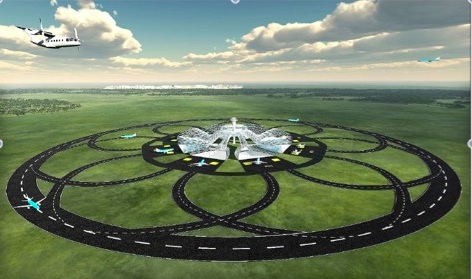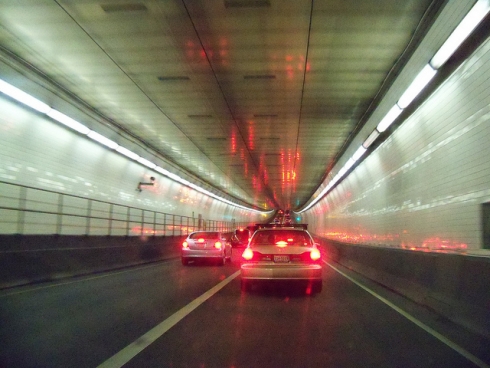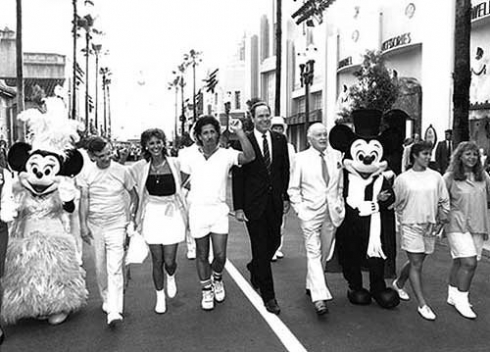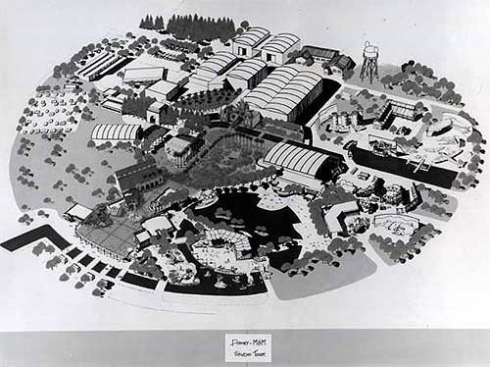3. There would be an innovative on-site airport

To bring guests into his new resort, Walt planned to build an on-site airport. Like so many other elements of Disney World, this would not feature a standard design. Instead, it would employ new methods for handling baggage and cargo, and getting passengers on and off planes. Incredibly, Walt was considering building an airport with a circular runway. According to Sam Gennaway's excellent Walt and the Promise of Progress City, at one stage Walt hoped to employ such a design, which would have seen planes accelerating for take-off by racing around a banked curve. This would have enabled the size of the airport to be cut in half. Whether or not he had pursued to the radial airport concept, it seems likely that Walt would have built a much larger airport than the modest Walt Disney World Airport that was eventually built, and which is currently not registered as an active airport with the FAA.
2. There'd be a LOT fewer roads and cars (above ground)

Walt Disney moved to Los Angeles during the 1920s, at a time when the automobile was beginning to change the landscape of America's cities. He was not happy with the impact that cars had on LA, although he did recognise the important role that they had to play in the modern world. Indeed, one of the first attractions at Disneyland was Autopia, which successfully predicted a future in which America would be criss-crossed by a network of multi-lane highways. At Disney World and particularly at EPCOT, Walt hoped to benefit from the flexibility that road travel enabled, but without it impacting on life in the city itself. Cars and other conventional forms of transportation would be hidden away, restricted to underground tunnels. A highway would pass directly underneath the city center, so that cars and buses could pass through without being stopped by traffic lights. Trucks and other service vehicles would travel one level lower, with loading docks and service elevators connecting to businesses up above. The effect of this would be to create a city which was free of the pollution associated with overground roads, and in which people were encouraged to walk or cycle and enjoy their surroundings.
1. Disney's Hollywood Studios would look very different (if it existed at all)

In the days when Walt Disney was in charge, and in the years immediately following his death, Disney took an aloof view of competitors in the tourism industry, describing them as "supporting" rather than "competing" amusements. Management believed that since Disney could not possibility build everything, such supporting amusements would help to pull in more visitors to the areas where it built its own attractions, and – more importantly – to demonstrate the superiority of Disney’s offerings. By 1984, though, things had changed. That year saw Michael Eisner (formerly CEO of Paramount's movie studio) and Frank Wells (formerly head of Warner Bros.) brought in as Disney's CEO and President respectively, in an ultimately successful attempt to strengthen the company and ward off hostile takeover attempts. Eisner and Wells immediately saw the potential to exploit Disney’s theme park business for increased profits, and prices began to rise. The company’s attitude to its neighbors also began to change. Hotels and other attractions surrounding Walt Disney World were no longer "supporters", but "competitors". SeaWorld Orlando had initially been welcomed to the area with open arms by Disney when it opened in 1973. Eisner, though, was happy to clone others’ ideas if it could lead to increased profit. A half-hearted attempt was made to compete directly with SeaWorld in 1986, when the Living Seas Pavilion was opened at Walt Disney World’s second theme park, EPCOT Center. The ploy failed (SeaWorld Orlando enjoyed record attendance that year), but the pattern was set. In the mid-1980s, Universal was looking for partners to help fund the construction of a version of its popular Studio Tour in Orlando. Eisner was not about to let Universal invade Disney's turf without a fight. Disney’s Imagineers had put together a plan for an entertainment-themed pavilion (dubbed the Great Movie Ride Pavilion) for EPCOT Center's Future World area, which had not been pursued. By expanding this into a full-sized, studio-themed park, Eisner surmised, Universal’s plans could be blown out of the water. 
Eisner had seen the plans for Universal's parks while still at Paramount. When Disney announced the plans for Disney-MGM Studios, it was immediately accused by Universal of copying them (allegations which were never proven). Universal was forced to completely reinvent its plans for Universal Studios Florida, which was eventually built, despite Eisner's hopes of heading it off at the pass. Was Walt Disney above copying other people's ideas? Not completely - certainly, some areas and attractions at Disneyland bore more than a passing resemblance to existing attractions (Knott's Berry Farm's Ghost Town, for example). But would he have countenanced such a wholesale clone of another company's offering (whether or not it borrowed from the Universal Studios Florida plans, Disney-MGM Studios definitely resembled Universal Studios Hollywood)? Probably not.

Add new comment